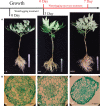PacBio full-length sequencing integrated with RNA-seq reveals the molecular mechanism of waterlogging and its recovery in Paeonia ostii
- PMID: 36407600
- PMCID: PMC9669713
- DOI: 10.3389/fpls.2022.1030584
PacBio full-length sequencing integrated with RNA-seq reveals the molecular mechanism of waterlogging and its recovery in Paeonia ostii
Abstract
Paeonia ostii, a widely cultivated tree peony species in China, is a resourceful plant with medicinal, ornamental and oil value. However, fleshy roots lead to a low tolerance to waterlogging in P. ostii. In this study, P. ostii roots were sequenced using a hybrid approach combining single-molecule real-time and next-generation sequencing platforms to understand the molecular mechanism underlying the response to this sequentially waterlogging stress, the normal growth, waterlogging treatment (WT), and waterlogging recovery treatment (WRT). Our results indicated that the strategy of P. ostii, in response to WT, was a hypoxic resting syndrome, wherein the glycolysis and fermentation processes were accelerated to maintain energy levels and the tricarboxylic acid cycle was inhibited. P. ostii enhanced waterlogging tolerance by reducing the uptake of nitrate and water from the soil. Moreover, transcription factors, such as AP2/EREBP, WRKY, MYB, and NAC, played essential roles in response to WT and WRT. They were all induced in response to the WT condition, while the decreasing expression levels were observed under the WRT condition. Our results contribute to understanding the defense mechanisms against waterlogging stress in P. ostii.
Keywords: hypoxia; transcriptome; tree peony; waterlogging; waterlogging recovery.
Copyright © 2022 Zhang, Liu, Zhou, Hu and Yuan.
Conflict of interest statement
The authors declare that the research was conducted in the absence of any commercial or financial relationships that could be construed as a potential conflict of interest.
Figures








Similar articles
-
New Insight into the Related Candidate Genes and Molecular Regulatory Mechanisms of Waterlogging Tolerance in Tree Peony Paeonia ostii.Plants (Basel). 2024 Nov 27;13(23):3324. doi: 10.3390/plants13233324. Plants (Basel). 2024. PMID: 39683117 Free PMC article.
-
Single molecule, full-length transcript sequencing provides insight into the TPS gene family in Paeonia ostii.PeerJ. 2021 Jul 15;9:e11808. doi: 10.7717/peerj.11808. eCollection 2021. PeerJ. 2021. PMID: 34316413 Free PMC article.
-
De novo sequencing, assembly, and analysis of the Taxodium 'Zhongshansa' roots and shoots transcriptome in response to short-term waterlogging.BMC Plant Biol. 2014 Jul 24;14:201. doi: 10.1186/s12870-014-0201-y. BMC Plant Biol. 2014. PMID: 25055883 Free PMC article.
-
Integrated analysis of miRNAome transcriptome and degradome reveals miRNA-target modules governing floral florescence development and senescence across early- and late-flowering genotypes in tree peony.Front Plant Sci. 2022 Dec 14;13:1082415. doi: 10.3389/fpls.2022.1082415. eCollection 2022. Front Plant Sci. 2022. PMID: 36589111 Free PMC article.
-
Molecular and physiological responses of trees to waterlogging stress.Plant Cell Environ. 2014 Oct;37(10):2245-59. doi: 10.1111/pce.12310. Epub 2014 Apr 7. Plant Cell Environ. 2014. PMID: 24611781 Review.
Cited by
-
New Insight into the Related Candidate Genes and Molecular Regulatory Mechanisms of Waterlogging Tolerance in Tree Peony Paeonia ostii.Plants (Basel). 2024 Nov 27;13(23):3324. doi: 10.3390/plants13233324. Plants (Basel). 2024. PMID: 39683117 Free PMC article.
-
Genome-Wide Identification of NAC Gene Family Members of Tree Peony (Paeonia suffruticosa Andrews) and Their Expression under Heat and Waterlogging Stress.Int J Mol Sci. 2024 Aug 28;25(17):9312. doi: 10.3390/ijms25179312. Int J Mol Sci. 2024. PMID: 39273263 Free PMC article.
-
Comprehensive transcriptome and proteome analysis revealed the molecular mechanisms of melatonin priming and waterlogging response in peach.Front Plant Sci. 2025 Feb 7;16:1527382. doi: 10.3389/fpls.2025.1527382. eCollection 2025. Front Plant Sci. 2025. PMID: 39990712 Free PMC article.
-
Transcriptomic and Metabolomic Analyses Reveal the Response Mechanism of Ophiopogon japonicus to Waterlogging Stress.Biology (Basel). 2024 Mar 20;13(3):197. doi: 10.3390/biology13030197. Biology (Basel). 2024. PMID: 38534466 Free PMC article.
-
Morphological and molecular response mechanisms of the root system of different Hemarthria compressa species to submergence stress.Front Plant Sci. 2024 Apr 4;15:1342814. doi: 10.3389/fpls.2024.1342814. eCollection 2024. Front Plant Sci. 2024. PMID: 38638357 Free PMC article.
References
LinkOut - more resources
Full Text Sources
Research Materials

